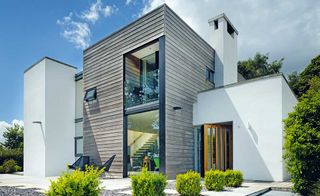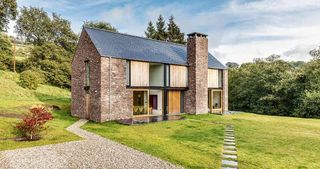How to find an architect: Track down your dream designer
Need help to find an architect for your project who ticks all your boxes and shares your vision? Check out our top ways to ensure your search for a designer is a success

Most projects start out with the quest to find an architect who will help you breeze through the design and planning of your self build, renovation or extension. But, with so much choice out there, it may feel like searching for a needle in a haystack to uncover the right one for you.
An architect’s knowledge and expertise is undoubtedly one of the most important factors to consider, but the right architect will also be able to translate an effective design into your personal style and be someone you feel comfortable working with.
In order to find your ideal match, we’ve pulled together our six golden rules to follow on the search for an architect for your home project.

How to find an architect
There are several good ways to assess your architect when it comes to finding a designer for your project and, in all honesty, many people use more than one.
Here, we take a look at the most highly recommended ways of tracking down and selecting the right architect for your project and also offer advice on how to clearly communicate your ideas to them so you can be sure you get the end result you want.
1. Create a brief before you start looking for an architect
Before you even begin approaching architects, you need to be thinking about design briefs and get one in place. A good architect will be keen to know exactly what you’re after so they can determine whether they are interested in taking the project on — and will also be able to show you any examples of previous work they have created in a similar style to the one you are after.
You don’t need to have a list of everything you want set in stone, but an idea on the following would be useful to steer your architect in the right direction:
- number of bedrooms
- number of bathrooms
- architectural styles you like
- materials you favour
- are you after an open plan arrangement?
2. Ask around for recommendations
Just as when you set out to find a builder, or anyone else you hire to work on your project – be it carpenters, electricians, plasterers etc – it’s always best if you can source someone who comes recommended by people you know and trust. Ask family, friends and neighbours if they’ve worked with an architect they’d recommend.
Failing that, one of the easiest ways to do this will be a simple Google search, targeting your local area. Check out social media too — Instagram is teaming with architects and designers showcasing their work. If you find any you like, they’re likely to have their contact details on these platforms where you can get in touch.
RIBA (The Royal Institute of British Architects) has a useful Find an Architect tool to help you search.
Be sure to ask to view any of their previous projects before taking them on and ask if you can speak to clients too.
Alternatively, it would pay you to get out and about in the area you’re building and spot any new homes you like the look of — there’s no harm in asking the owner who carried out the work.
The benefit of a local architect will also mean they’re familiar with designing homes which suit the vernacular, might be friendly with the local planning authority, and might also be able to go on to recommend local builders who they’ve worked on projects with before.
Once you have found a selection of architectural firms, invite them to come to the site and meet with you to discuss your project — ideally you’ll want to interview at least four architects to see what design proposals they can come up with, judge whether you’ll get on and be able to work together, see whether they can produce the kind of home you’re after, and also you’ll be able to gauge a greater understanding of whether your dream home is realistic and affordable.

3. Search for someone you have a good rapport with
Your architect is the person you’re trusting to design your dream home. You’ll be investing a lot of money not just in the project but in the design stage itself, and you need to be able to feel you can approach them about anything.
When interviewing various architects for the job, one of the deciding factors should be whether you get on, and whether you feel confident enough that you’d be able to approach them about anything. This will help it all run smoothly.
A breakdown in communication can have a lasting effect on the whole project, so when choosing your architect make sure you can depend on them and that you’re both comfortable.
4. Insist on hiring someone who knows the local planners
When choosing an architect, it can make all the difference if they have previous (successful) experience of dealing with local planners.
While planning permission for certain projects will always be contentious, regardless of whether your project is small and simple or large and detailed, it pays to have someone fighting your corner who is familiar with your planning authority — they will know what might or might not gain approval, they will have an understanding of the success rate of other projects in the area, and will have built a rapport with those deciding your fate.
5. Stick to architects whose work you admire
These days, one of the easiest and quickest ways of viewing an architect’s previous work will be via their website.
A practice’s website will be their main selling tool, and chances are there will be a handful of well-photographed projects for you to browse through. This will give you an indication as to the calibre of work they produce, the architectural style they might specialise in, materials they’re familiar with and the construction systems they’re used to working with.
It is important you like their work and know they can deliver the style of home you’re after.
6. Be sure your architect is a good listener
When interviewing different architects for the job, you’ll discuss your brief and chances are they will present various ideas there and then about how to make your dreams a reality.
Be careful though that when you’re discussing your must-haves and like-to-haves that they don’t steer you away from your plans. Their role as creatives is to develop your brief, but to also make sure they listen to what you want and don’t try to change it.
Many homeowners will express their delight that their architect was able to design a home better than they could have imagined; just be careful that things don’t get carried away and you sacrifice certain elements you’ve longed for, all because an impulsive designer went rogue and wanted to try something new.
7. Ensure your architect understands your budget
Whether you are building an extension, renovating an old property or self building, designing your home will take up a large chunk of your overall budget — which is why it is so important to get this part right and make sure you’re happy with it.
What you have to remember however, is that, unless you have unlimited funds to throw at the project, you need to be sensible.
Be upfront with your architect from the outset and they should be realistic with you in terms of what can be achieved within your price range. Also don’t let them talk you into architectural features that will add to the overall cost, but that perhaps you don’t really need.
When choosing an architect to handle your project, ensure that they are well aware of how much you’re willing to spend from the outset and work out whether they will be able to work up a design that sits neatly within your budget.
Get the Homebuilding & Renovating Newsletter
Bring your dream home to life with expert advice, how to guides and design inspiration. Sign up for our newsletter and get two free tickets to a Homebuilding & Renovating Show near you.
Claire is Editor in Chief of Homebuilding & Renovating website and magazine. She became Editor of Homebuilding & Renovating in 2016 and has been a member of the team for 15 years. An experienced homes journalist, her work has also appeared in titles such as Real Homes and Period Living.
She has a particular interest in green homes and sustainability, and interior design is a passion too; she has undertaken qualifications in this area.
After finishing a major renovation of a period cottage, she is now onto her next project: overhauling a 1930s property in the Shropshire countryside.
